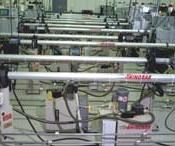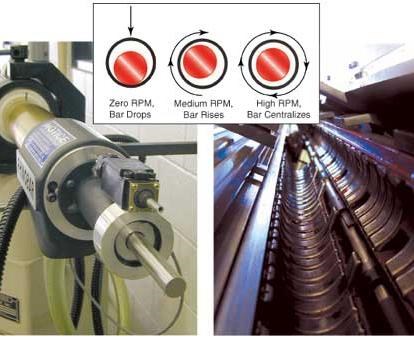What Is The Best Bar Feed System For Production Turning?
Selecting the right bar feeder can be one of the most important decisions a shop can make. Bar feed systems help improve productivity, throughput and quality, but in order to achieve the most benefit from them it is essential that a bar feed system be matched to the particular needs of the turning operation.
There are two generic types of bar feeders available—the hydrostatic type and the hydrodynamic type. Both offer distinct advantages for specific applications.
Defining Terms
In a hydrostatic bar feed system, the bar rests in a series of guide channels, usually made of a plastic material. These channels resemble clamshells, with a top half and a bottom half that close around the stock to hold it in place and provide stability during the turning operation. These guide channels will generally accept a wide range of sizes before having to be changed. Hydrostatic bar feed systems are magazine type systems, generally with a 12-foot bar capacity, which automatically reload bar stock.
In a hydrodynamic bar feed system, bar stock is held in a feed tube and surrounded by pressurized flowing of oil. Most hydrodynamic bar feed systems require that bar stock be manually reloaded one bar at a time. To change bar stock size capacity in a hydrodynamic bar feed system, the feed tube must be changed.
The bottom line for any bar feed unit is to help automate the delivery of stock for making precision parts. This article looks at two of the more popular choices for accomplishing the task.
Another difference, in addition to the basic design of each system, is how each uses hydraulic oil. In the hydrostatic system, large volumes of oil are pumped into each closed guide channel to create hydrodynamic support, while the bar pushing or bar advance mechanism is independent of the oil system and is operated by servomotor.
The hydrodynamic bar feed system uses oil to both exert pressure on the pusher piston for advancing the stock as well as supply oil to the front of the feed tube for developing hydrodynamic support. As the bar spins, oil encircles it and pushes against it, as well as against the feed tube ID, to create a fluid bearing or hydrodynamic wedge. This action serves to center the bar stock in the feed tube, as well as acts as a noise dampener. As bar speed increases, the centering forces increase.
Unattended Versus Attended Operation
Which one is better? The selection depends entirely on the application; however, each type has performance factors that should be understood before a purchasing decision is made. Let’s look at a typical application, a single spindle Swiss-type CNC lathe, to establish a base for comparison.
The first consideration for selecting a bar feed system for this machine is part quantity. As a rule of thumb, if part runs are in the thousands, a full-length magazine-style hydrostatic bar feed system would be the best choice. This is because the hydrostatic magazine type bar feeder is essentially an automated system. If high volume part runs require unattended machine operation for efficiency, the hydrostatic type bar feeder will meet operational needs more closely than a hydrodynamic type system.
If production runs are in the hundreds of parts, a hydrodynamic bar feed system will work well. A hydrodynamic bar feed system can be considered part time automation. An operator can still effectively tend to multiple machines when part runs are in the hundreds. Even though hydrodynamic bar feeders require that single bars be manually loaded, throughput disruptions are minimal with low volume part runs.
This leads to another critical purchasing consideration—the length of the part being made and the cycle time necessary to make it. If the machining cycle time is fast and the part is long, a 12-foot bar doesn’t last more than 10 minutes or so in some machines. If this is the case, a hydrostatic type full length magazine bar feeder should be considered. Its ability to automatically load stock makes it the best choice for this application.
Where parts are small or are machined from a tough to cut material requiring a lengthy cycle time, it might take all day to consume one 12-foot bar. Generally, with that type of application, the operator is always present. The operator is always checking parts, probably every other part, so the need for full automation is not necessary and the hydrodynamic bar feed system would be the most cost effective choice.
There is a trend today to run higher and higher rpm, especially in single spindle Swiss-style machines. As rpm increase so does the instability of the bar. The closer the ID of the feed tube is to the diameter of the stock, the more stability the system affords and the higher the rpm can go. With a hydrodynamic bar feed system, the customer can economically select the optimum feed tube ID. Hydrodynamic bar feed system manufacturers such as Lexair build feed tubes in small incremental diameters, 1/8 inch in Lexair’s case, and can build specials to accommodate any bar stock diameter.
This flexibility is a key benefit of a hydrodynamic bar feed system. If a shop runs a lot of different diameter bars and produces small part quantities, the quick and simple changeover to the proper feed tube size makes the hydrodynamic bar feed system a good choice. Changeover can be completed in under a minute. Hydrostatic systems, because the guide channels have to be swapped to accommodate a different stock size, require a longer changeover, necessitating longer machine downtime.
Considering The Bottom Line
Cost is a major consideration in selecting the right bar feed system. A hydrodynamic bar feeder runs between $10,000 and $20,000. A hydrostatic bar feed system can cost from $20,000 to $50,000, with many falling in the $30,000 to $35,000 range. However, the cost of the bar feed system must be weighed with the cost of the turning equipment. A few years ago, a screw machine could cost $200,000, and it wasn’t difficult to justify a $30,000 to $40,000 hydrostatic bar feed system for it. Now, with Swiss-type screw machines selling in the $70,000 range, it can be hard to justify spending 50 percent of the purchase price on a hydrostatic bar feed system, when a lower cost hydrodynamic system could be viable alternative, depending on the type of turning operation in which the machine will be used. Hydrodynamic bar feeders are also good choices to equip used screw machines. The key selection considerations, again, are part quantity, part length and cycle time.
Each type of bar feed system supports stock well, and if set up properly, there is no significant difference in the actual bar feeding performance of the two systems.
Make the purchasing decision based on how the system will be used. With that criterion in mind, you will pick the best bar feed system for your applications.
Related Content
Bar Feeder for Sliding Headstock Lathes Enables Higher RPMs
PMTS 2023: The LNS GT 342 automatic magazine bar feeder is designed to enable fast and easy diameter changeovers and improved productivity.
Read MoreBar Feeder Offers Simple, Fast, Silent Automation
PMTS 2023: Bucci Industries’ Next 25 bar feeder offers high rotational speeds (more than 10,000 rpm) and fast, unattended bar changes with high indexing and silent performance.
Read MoreRead Next
Emerging Leaders Nominations Now Open
Here’s your chance to highlight a young person in your manufacturing business who is on the path to be a future leader moving your company forward.
Read MoreDo You Have Single Points of Failure?
Plans need to be in place before a catastrophic event occurs.
Read MoreA Tooling Workshop Worth a Visit
Marubeni Citizen-Cincom’s tooling and accessory workshop offers a chance to learn more about ancillary devices that can boost machining efficiency and capability.
Read More














.jpg;maxWidth=300;quality=90)







